一、Redis 中的 IO 多线程原理
服务端收到一条信息,给它 deconde 成一条命令
然后根据命令获得一个结果(reply)
然后将结果 encode 后,发送回去
redis 的单线程是指,命令执行(logic)都是在单线程中运行的
接受数据 read 和发送数据 write 都是可以在 io 多线程(线程池)中去运行
在 Redis 中,生产者也可以作为消费者,反之亦然,没有明确界限。
二、设置 io 多线程(调试设置)
在 redis.conf 中
设置 io-threads-do-reads yes 就可以开启 io 多线程
设置 io-threads 2,设置为 2(为了方便调试,真正使用的时候,可以根据需要设置),其中一个为主线程,另外一个是 io 线程
在 networking.c 中找到 stopThreadedIOIfNeeded,如果在 redis-cli 中输入一条命令,是不会执行多线程的,因为它会判断,如果 pending(需要做的命令)个数比 io 线程数少,就不会执行多线程
因此提前 return 0,确保执行多线程,便于调试
int stopThreadedIOIfNeeded(void) { int pending = listLength(server.clients_pending_write);
/* Return ASAP if IO threads are disabled (single threaded mode). */ if (server.io_threads_num == 1) return 1; return 0;//为了调试,提前退出(自己添加的一行) if (pending < (server.io_threads_num*2)) { if (server.io_threads_active) stopThreadedIO(); return 1; } else { return 0; }}
复制代码
到此为止,只需要,运行 redis-server,在 networking.c 的 readQueryFromClient 中打个断点,然后在 redis-cli 中输入任意 set key value 就可以进入 io 多线程,进行调试
下图可以看到箭头指向的两个线程,一个是主线程,另一个是 io 线程
C++后台开发系统学习视频地址:C/C++Linux服务器开发高级架构师/C++后台开发架构师
以下学习资料,C++后台开发面试题,教学视频,C++后台开发学习路线图,免费分享有需要的可以自行添加:学习资料群720209036 进群自取
三、Redis 中的 IO 线程池
1、读取任务 readQueryFromClient
postponeClientRead(c)就是判断 io 多线程模式,并将任务添加到 任务队列中
void readQueryFromClient(connection *conn) { client *c = connGetPrivateData(conn); int nread, big_arg = 0; size_t qblen, readlen;
/* Check if we want to read from the client later when exiting from * the event loop. This is the case if threaded I/O is enabled. */ if (postponeClientRead(c)) return; //后面省略......}
复制代码
2、主线程将 待读客户端 添加到 Read 任务队列(生产者)postponeClientRead
如果是 io 多线程模式,那么将任务添加到任务队列。
(这个函数名的意思,延迟读,就是将任务加入到任务队列,后续去执行)
int postponeClientRead(client *c) { if (server.io_threads_active && server.io_threads_do_reads && !ProcessingEventsWhileBlocked && !(c->flags & (CLIENT_MASTER|CLIENT_SLAVE|CLIENT_BLOCKED)) && io_threads_op == IO_THREADS_OP_IDLE) { listAddNodeHead(server.clients_pending_read,c);//往任务队列中插入任务 c->pending_read_list_node = listFirst(server.clients_pending_read); return 1; } else { return 0; }}
复制代码
3、多线程 Read IO 任务 handleClientsWithPendingReadsUsingThreads
基本原理和多线程 Write IO 是一样的,直接看多线程 Write IO 就行了。
其中 processInputBuffer 是解析协议
int handleClientsWithPendingReadsUsingThreads(void) { if (!server.io_threads_active || !server.io_threads_do_reads) return 0; int processed = listLength(server.clients_pending_read); if (processed == 0) return 0;
/* Distribute the clients across N different lists. */ listIter li; listNode *ln; listRewind(server.clients_pending_read,&li); int item_id = 0;
while((ln = listNext(&li))) { client *c = listNodeValue(ln); int target_id = item_id % server.io_threads_num; listAddNodeTail(io_threads_list[target_id],c); item_id++; }
/* Give the start condition to the waiting threads, by setting the * start condition atomic var. */ io_threads_op = IO_THREADS_OP_READ; for (int j = 1; j < server.io_threads_num; j++) { int count = listLength(io_threads_list[j]); setIOPendingCount(j, count); }
/* Also use the main thread to process a slice of clients. */ listRewind(io_threads_list[0],&li); while((ln = listNext(&li))) { client *c = listNodeValue(ln); readQueryFromClient(c->conn); } listEmpty(io_threads_list[0]);
/* Wait for all the other threads to end their work. */ while(1) { unsigned long pending = 0; for (int j = 1; j < server.io_threads_num; j++) pending += getIOPendingCount(j); if (pending == 0) break; }
io_threads_op = IO_THREADS_OP_IDLE;
/* Run the list of clients again to process the new buffers. */ while(listLength(server.clients_pending_read)) { ln = listFirst(server.clients_pending_read); client *c = listNodeValue(ln); listDelNode(server.clients_pending_read,ln); c->pending_read_list_node = NULL;
serverAssert(!(c->flags & CLIENT_BLOCKED));
if (beforeNextClient(c) == C_ERR) { /* If the client is no longer valid, we avoid * processing the client later. So we just go * to the next. */ continue; }
/* Once io-threads are idle we can update the client in the mem usage buckets */ updateClientMemUsageBucket(c);
if (processPendingCommandsAndResetClient(c) == C_ERR) { /* If the client is no longer valid, we avoid * processing the client later. So we just go * to the next. */ continue; }
if (processInputBuffer(c) == C_ERR) { /* If the client is no longer valid, we avoid * processing the client later. So we just go * to the next. */ continue; }
/* We may have pending replies if a thread readQueryFromClient() produced * replies and did not install a write handler (it can't). */ if (!(c->flags & CLIENT_PENDING_WRITE) && clientHasPendingReplies(c)) clientInstallWriteHandler(c); }
/* Update processed count on server */ server.stat_io_reads_processed += processed;
return processed;}
复制代码
4、多线程 write IO 任务(消费者)handleClientsWithPendingWritesUsingThreads
1.判断是否有必要开启 IO 多线程
2.如果没启动 IO 多线程,就启动 IO 多线程
3.负载均衡:write 任务队列,均匀分给不同 io 线程
4.启动 io 子线程
5.主线程执行 io 任务
6.主线程等待 io 线程写结束
/* This function achieves thread safety using a fan-out -> fan-in paradigm: * Fan out: The main thread fans out work to the io-threads which block until * setIOPendingCount() is called with a value larger than 0 by the main thread. * Fan in: The main thread waits until getIOPendingCount() returns 0. Then * it can safely perform post-processing and return to normal synchronous * work. */int handleClientsWithPendingWritesUsingThreads(void) { int processed = listLength(server.clients_pending_write); if (processed == 0) return 0; /* Return ASAP if there are no clients. */
/* If I/O threads are disabled or we have few clients to serve, don't * use I/O threads, but the boring synchronous code. */ if (server.io_threads_num == 1 || stopThreadedIOIfNeeded()) {//判断是否有必要开启IO多线程 return handleClientsWithPendingWrites(); }
/* Start threads if needed. */ if (!server.io_threads_active) startThreadedIO();//开启io多线程
/* Distribute the clients across N different lists. */ listIter li; listNode *ln; listRewind(server.clients_pending_write,&li);//创建一个迭代器li,用于遍历任务队列clients_pending_write int item_id = 0;//默认是0,先分配给主线程去做(生产者也可能是消费者),如果设置成1,则先让io线程1去做 //io_threads_list[0] 主线程 //io_threads_list[1] io线程 //io_threads_list[2] io线程 //io_threads_list[3] io线程 //io_threads_list[4] io线程 while((ln = listNext(&li))) { client *c = listNodeValue(ln);//取出一个任务 c->flags &= ~CLIENT_PENDING_WRITE;
/* Remove clients from the list of pending writes since * they are going to be closed ASAP. */ if (c->flags & CLIENT_CLOSE_ASAP) {//表示该客户端的输出缓冲区超过了服务器允许范围,将在下一次循环进行一个关闭,也不返回任何信息给客户端,删除待读客户端 listDelNode(server.clients_pending_write, ln); continue; }
/* Since all replicas and replication backlog use global replication * buffer, to guarantee data accessing thread safe, we must put all * replicas client into io_threads_list[0] i.e. main thread handles * sending the output buffer of all replicas. */ if (getClientType(c) == CLIENT_TYPE_SLAVE) { listAddNodeTail(io_threads_list[0],c); continue; } //负载均衡:将任务队列中的任务 添加 到不同的线程消费队列中去,每个线程就可以从当前线程的消费队列中取任务就行了 //这样做的好处是,避免加锁。当前是在主线程中,进行分配任务 //通过取余操作,将任务均分给不同io线程 int target_id = item_id % server.io_threads_num; listAddNodeTail(io_threads_list[target_id],c); item_id++; }
/* Give the start condition to the waiting threads, by setting the * start condition atomic var. */ io_threads_op = IO_THREADS_OP_WRITE; for (int j = 1; j < server.io_threads_num; j++) { int count = listLength(io_threads_list[j]); setIOPendingCount(j, count);//设置io线程启动条件,启动io线程 }
/* Also use the main thread to process a slice of clients. */ listRewind(io_threads_list[0],&li);//让主线程去处理一部分任务(io_threads_list[0]) while((ln = listNext(&li))) { client *c = listNodeValue(ln); writeToClient(c,0); } listEmpty(io_threads_list[0]);
/* Wait for all the other threads to end their work. */ while(1) {//剩下的任务io_threads_list[1],io_threads_list[2].....给io线程去做,等待io线程完成任务 unsigned long pending = 0; for (int j = 1; j < server.io_threads_num; j++) pending += getIOPendingCount(j);//等待io线程结束,并返回处理的数量 if (pending == 0) break; }
io_threads_op = IO_THREADS_OP_IDLE;
/* Run the list of clients again to install the write handler where * needed. */ listRewind(server.clients_pending_write,&li); while((ln = listNext(&li))) { client *c = listNodeValue(ln);
/* Update the client in the mem usage buckets after we're done processing it in the io-threads */ updateClientMemUsageBucket(c);
/* Install the write handler if there are pending writes in some * of the clients. */ if (clientHasPendingReplies(c) && connSetWriteHandler(c->conn, sendReplyToClient) == AE_ERR) { freeClientAsync(c); } } listEmpty(server.clients_pending_write);
/* Update processed count on server */ server.stat_io_writes_processed += processed;
return processed;}
复制代码
负载均衡:将任务队列中的任务 添加 到不同的线程消费队列中去,每个线程就可以从当前线程的消费队列中取任务就行了。这样做的好处是,避免加锁。当前是在主线程中,进行分配任务通过取余操作,将任务均分给不同的 io 线程。
四、线程调度
1、开启 io 线程 startThreadedIO
每个 io 线程都有一把锁,如果主线程把锁还回去了,那么 io 线程就会启动,不再阻塞
并设置 io 线程标识为活跃状态 io_threads_active=1
void startThreadedIO(void) { serverAssert(server.io_threads_active == 0); for (int j = 1; j < server.io_threads_num; j++) pthread_mutex_unlock(&io_threads_mutex[j]); server.io_threads_active = 1;}
复制代码
2、关闭 io 线程 stopThreadedIO
每个 io 线程都有一把锁,如果主线程拿了,那么 io 线程就会阻塞等待,也就是停止了 IO 线程
并设置 io 线程标识为非活跃状态 io_threads_active=0
void stopThreadedIO(void) { /* We may have still clients with pending reads when this function * is called: handle them before stopping the threads. */ handleClientsWithPendingReadsUsingThreads(); serverAssert(server.io_threads_active == 1); for (int j = 1; j < server.io_threads_num; j++) pthread_mutex_lock(&io_threads_mutex[j]);// server.io_threads_active = 0;}
复制代码
参考资料
推荐一个零声教育 C/C++后台开发的免费公开课程,个人觉得老师讲得不错,分享给大家:C/C++后台开发高级架构师,内容包括Linux,Nginx,ZeroMQ,MySQL,Redis,fastdfs,MongoDB,ZK,流媒体,CDN,P2P,K8S,Docker,TCP/IP,协程,DPDK等技术内容,立即学习
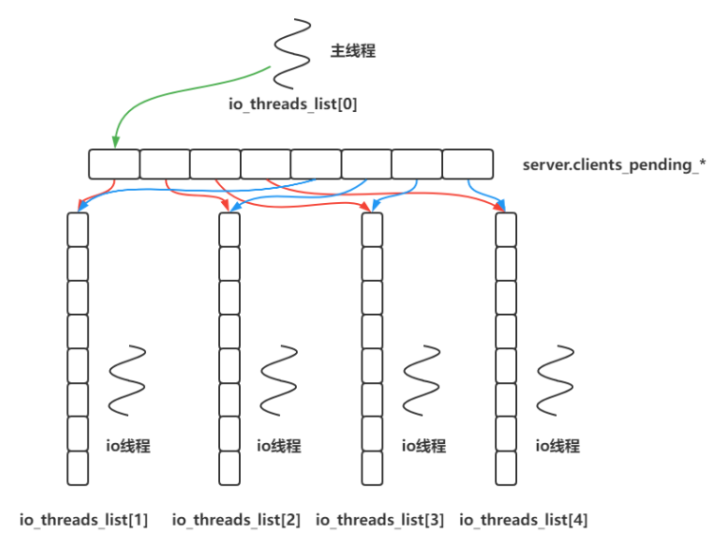
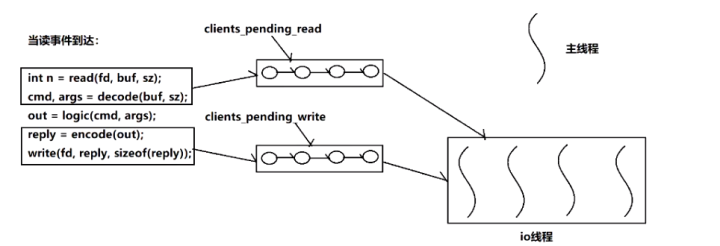
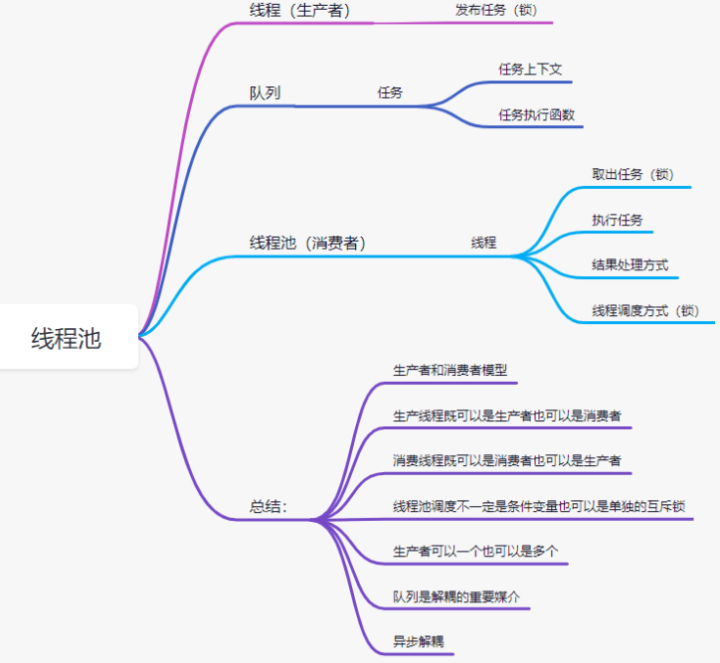
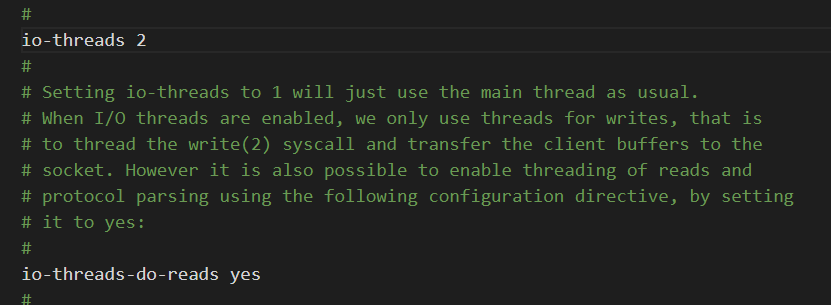
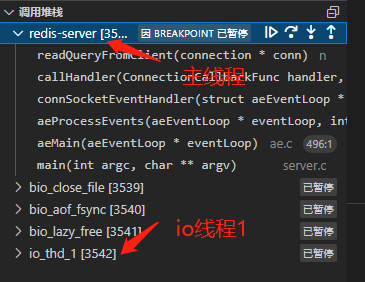
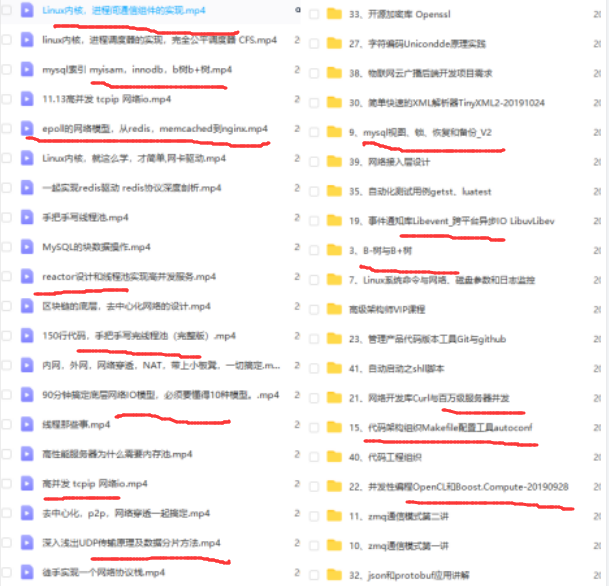











评论